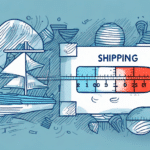Understanding Billable Weight in Shipping and Logistics
Shipping and logistics are vital components of modern business operations. The efficiency and effectiveness of these processes directly influence a company's success. A critical aspect of shipping and logistics is understanding the concept of billable weight. This comprehensive guide will help you grasp what billable weight is, its significance, how to calculate it, and strategies to reduce it.
What is Billable Weight and How is it Calculated?
Billable weight is the weight used to determine the cost of shipping goods. It is calculated by comparing the actual weight and the dimensional weight of a shipment, with the higher value being the billable weight.
Calculating Dimensional Weight
Dimensional weight is calculated using the formula:
Dimensional Weight = (Length × Width × Height) / Dimensional FactorThe dimensional factor varies by carrier and type of shipment. For example, air freight typically uses a factor of 166. If a shipment weighs 100 pounds but has a dimensional weight of 150 pounds, the billable weight will be 150 pounds.
Carrier-Specific Factors
Different shipping companies may use varying factors to calculate dimensional weight. It's essential to consult the specific carrier's guidelines to ensure accurate cost estimation. Additionally, some carriers may have different rules based on shipment type or destination.
For more details on dimensional weight calculations, refer to the comprehensive guide on dimensional weight.
Actual Weight vs. Dimensional Weight
Understanding the distinction between actual weight and dimensional weight is crucial for accurate billing and cost management.
Actual Weight
The actual weight is the true weight of the shipment, measured using a scale.
Dimensional Weight
Dimensional weight accounts for the volume a shipment occupies. It's especially relevant for lightweight but bulky items, such as pillows or electronics in large packaging.
For example, a shipment of pillows might have an actual weight of 80 pounds but a dimensional weight of 120 pounds, making 120 pounds the billable weight.
Why Billable Weight Matters
Billable weight significantly impacts shipping costs and the overall efficiency of logistics operations.
Cost Implications
The higher the billable weight, the more expensive the shipment becomes. Shipping companies consider both the weight and space occupied by the shipment, influencing their pricing structures.
Operational Efficiency
Higher billable weights reduce the number of shipments that can be transported simultaneously, potentially leading to longer delivery times and increased operational costs.
According to the Global Shipping Industry Statistics, optimizing billable weight can lead to significant cost savings and improved efficiency.
The Impact of Billable Weight on Shipping Costs
Billable weight is a primary determinant of shipping costs, especially in air freight where rates are often based on dimensional weight.
Reducing Packaging Weight
Using lighter packaging materials, such as bubble wrap instead of foam peanuts, can significantly reduce the overall weight of a shipment.
Optimizing Packaging Size
Choosing appropriately sized packaging minimizes the dimensional weight, leading to lower shipping costs.
Research from the Logistics Management highlights that efficient packaging can reduce shipping costs by up to 15%.
Determining the Billable Weight of Your Shipment
Accurately determining billable weight involves calculating both actual and dimensional weights and selecting the higher value.
Step-by-Step Calculation
- Measure the actual weight using a reliable scale.
- Calculate the dimensional weight using the formula:
- Compare the actual and dimensional weights.
- Select the higher value as the billable weight.
Dimensional Weight = (Length × Width × Height) / Dimensional FactorAutomated shipping calculators and dimensional scanners can streamline this process, ensuring accuracy and efficiency.
Strategies to Reduce Billable Weight and Save on Shipping Costs
Implementing effective strategies to reduce billable weight can lead to substantial cost savings.
Optimize Packaging
Use the smallest possible packaging that safely accommodates your products. This reduces both actual and dimensional weights.
Select Lightweight Materials
Choose packaging materials that offer sufficient protection while minimizing weight. Materials like poly mailers or lightweight boxes can be effective alternatives.
Consolidate Shipments
Combining multiple shipments into a single package can reduce overall costs by minimizing packaging and transportation fees.
Choose Cost-Effective Shipping Methods
Evaluate different shipping methods based on destination and urgency. Ground shipping, for instance, is often more cost-effective than air shipping for non-urgent deliveries.
Common Mistakes to Avoid When Calculating Billable Weight
Avoiding common errors in calculating billable weight is essential for accurate cost estimation.
Incorrect Dimensional Factor
Using the wrong dimensional factor can lead to inaccurate billable weight. Always verify the factor with your shipping carrier.
Ignoring Packaging Weight
Failing to include the weight of pallets, crates, or packing materials can result in underestimating the billable weight.
Overlooking Shipment Density
Not considering the density of your shipment can lead to incorrect billing. Ensure you account for both weight and volume.
Unanticipated Additional Charges
Be aware of potential extra fees for oversized, overweight, or specially handled shipments to avoid unexpected costs.
Examples of Billable Weight Calculations
Understanding through examples can clarify the concept of billable weight.
- Package A: Actual weight: 50 lbs; Dimensional weight: 75 lbs. Billable weight: 75 lbs.
- Shipment B: Actual weight: 80 lbs; Dimensional weight: 120 lbs. Billable weight: 120 lbs.
- Pallet C: Actual weight: 1500 lbs; Dimensional weight: 2500 lbs. Billable weight: 2500 lbs.
Remember, factors like distance and additional services can influence the final cost. Always consult with your shipping provider for specific pricing policies.
The Importance of Accurate Billable Weight Reporting
Accurate reporting of billable weight is crucial for maintaining cost efficiency and operational effectiveness in shipping and logistics.
Financial Implications
Inaccurate billable weight can lead to unexpected charges, affecting profitability and budget forecasts.
Operational Efficiency
Proper weight reporting ensures optimal use of transportation resources, reducing waste and improving delivery times.
Implementing Accurate Reporting Systems
Investing in reliable weighing scales, dimensional scanners, and adhering to carrier guidelines helps maintain accuracy in billable weight reporting.
According to the Forbes Technology Council, businesses that prioritize accurate weight reporting can achieve up to a 20% reduction in shipping costs.
Conclusion
Understanding and accurately calculating billable weight is essential for businesses reliant on shipping and logistics. By implementing strategies to optimize packaging, selecting appropriate shipping methods, and avoiding common calculation mistakes, companies can significantly reduce shipping costs and enhance operational efficiency. Additionally, accurate billable weight reporting contributes to better financial management and supports sustainable shipping practices.
Embracing these practices not only improves the bottom line but also fosters a more sustainable and efficient logistics framework, positioning businesses for long-term success.






















